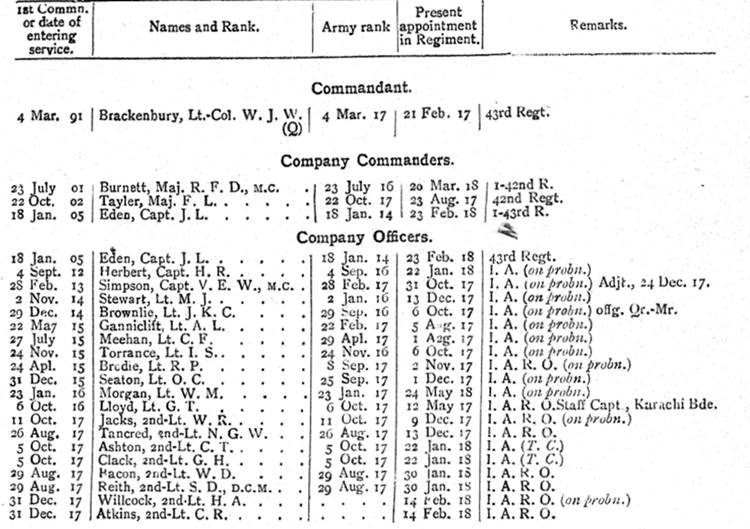This article is about the short-lived 2nd Battalion 42nd Deoli Regiment and aims to help you research the Battalion and soldiers who served with it during the First World War. I have written a separate article for the 1st Battalion 42nd Deoli and a series of guides to help you find out even more about researching soldiers who served in the Indian Army. The links below will take you to the guides:
- Guide to the 1st Battalion 42nd Deoli Regiment
- Guides to Researching Soldiers who Served in the Indian Army
The 2nd Battalion 42nd Deoli Regiment in the First World War
Lineage: The 2nd Battalion 42nd Deoli Regiment was formed at Deoli (Rajasthan, India) on 12 January 1917 and was disbanded on 20 July 1921. For a history of the Regiment’s lineage see my page on the 1st Battalion 42nd Deoli Regiment.
Class Composition of Battalion in April 1919: 4 Companies of Rajputana Hindus and Muslims.
The 2nd Battalion 42nd Deoli Regiment was a short-lived Indian infantry battalion formed at Deoli (Rajasthan, India) on 12 January 1917. The Battalion’s first commanding officer was Lieutenant-Colonel Walter John William Brackenbury who was appointed from the 43rd Erinpura Regiment on 21 February 1917. Like other war-raised Indian battalions, the majority of its British officers were either Indian Army officers on probation or drawn from the Indian Army Reserve of Officers. Below is part of the Indian Army List July 1918 entry for the Battalion showing its British officers. T.C. stands for temporary commission, probn. for probation. There’s usually a wide variety of sources to consult for these officers.
War Diary of the 2nd Battalion 42nd Deoli Regiment
There is only one war diary for the 2nd Battalion 42nd Deoli Regiment which as of February 2017 hasn’t been digitized and can only be viewed at the National Archives. I have a copy of the war diary and have transcribed some entries below.
- Date: 12 February 1918 – 30 January 1919
- 31st Infantry Brigade, 10th (Irish) Division, Egyptian Expeditionary Force
- Reference: WO 95/4586
- Notes: A good war diary with plenty of information about the Battalion with British and Indian officers mentioned frequently throughout. There are appendices for movement orders for the 2nd Battalion 42nd Deoli Regiment dated 9 June 1918, and 22 June 1918, 14 July 1918, 12 September 1918, 17 September 1918, 1 October 1918, 14 October 1918, 5 November 1918, 21 November 1918.
Further Sources of the 2nd Battalion 42nd Deoli Regiment
For information regarding the British and Indian officers who served with the 2nd Battalion 42nd Deoli, the Indian Army List should be consulted. The confidential reports for the Battalion are held at the British Library: Confidential Reports on Regiments etc. These reports also contain the annual reports of the British officers serving with the Battalion. However, when the 2nd Battalion 42nd Deoli Regiment was abroad only its Depot and the British officers serving with it were reported on.
Extracts from War Diaries of the 2nd Battalion 42nd Deoli Regiment
12 February 1918 – 30 January 1919, Egyptian Expeditionary Force, WO 95/4586
12th February 1918 – Sibi – Mobilization orders for Force E arrived.
28th February 1918 – Sibi – Owing to a rising of the Marri tribe, the mobilization of the Battalion has been greatly hindered since 21st February 1918, the Regiment being on duty at various railway stations on the line to Harnai and finding guards and picquets in and around Sibi.
22nd May 1918 – Suez – Arrived at port of disembarkation after an uneventful voyage at 6 am and disembarked at 11 pm, entraining with 415 all ranks of 110th Mahratta Light Infantry. 10 men left behind at Suez General Hospital.
5th June 1918 – Tel-el-Kebir – No. 3593 Sepoy Gordhana C Company sentenced to 20 lashes, for threatening his superior officer, and duly carried out.
17th July 1918 – Beit Rima – Box respirators arrived for whole Battalion (950). 2 77 mm shells (High Explosive) fell near Battalion Headquarters at 12.25. no damage.
29th July 1918 – Beit Rima – 1 cook killed and 3 other ranks (babu Daniel) wounded by 4.2″ shell from High Explosive at 4.20 pm.
20th September 1918 – 06.30 – Battalion deployed for the attack, B and C in the firing line, D in support and A Company in reserve. Moved forward at 06.30 to head of Wady Mutwy without opposition, the three leading companies under command of Major Taylor.
08.00 – At this time the leading companies were held up in the defile by intense artillery and machine gun fire, which in spite of support from our machine guns was not overcome for some considerable time. Eventually the leading companies issued from the defile by the left lank and were then able to continue towards their objective (first) which was reached at 10.15 hours after heavy casualties.
Headquarters then moved up and ascertained the situation, which was that the enemy still held the sunken end of the hill, that the men had had a hard time and were running short of ammunition. On this being supplied the advance continued at 14.00 supported by 4 machine guns and a flank attack from the right by a portion of the 151st Infantry. This attack was met by a very strong artillery and machine gun fire, but in the end failed to clear the hill.
23rd September 1918 – No. 3476 Sepoy Sugan Khan and commanding officers bearer both accidentally wounded by a Turkish bomb, the former died of injuries after admitted to hospital.
